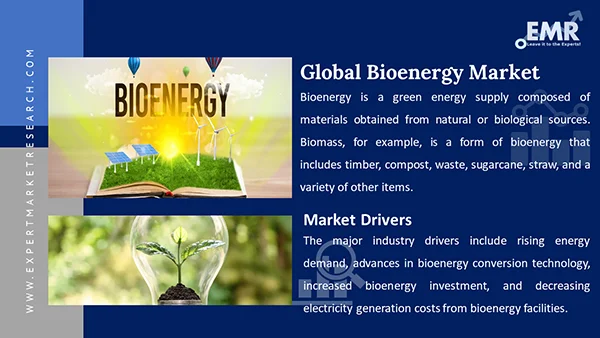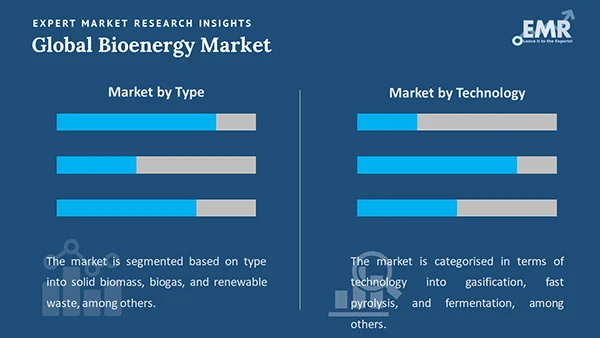
Consumer Insights
Uncover trends and behaviors shaping consumer choices today
Procurement Insights
Optimize your sourcing strategy with key market data
Industry Stats
Stay ahead with the latest trends and market analysis.
Trending Now



The global bioenergy market reached nearly 183.37 Gigawatt in 2024. The market is assessed to grow at a CAGR of 7.30% during the forecast period of 2025-2034 to attain 370.96 Gigawatt by 2034. The market is being driven by the growing renewable energy generation, the increasing emphasis on sustainability, technological advancements and innovations, the rising use of bioenergy in the transportation sector, and the development of advanced biofuels.
Base Year
Historical Year
Forecast Year






The increasing shift towards renewables and other non-fossil fuel-based energy sources, such as solid biomass, biogas, and others, is a major contributor to the bioenergy market growth. During the projected period, factors such as rising energy demand, advances in bioenergy conversion technology, increased bioenergy investment, and decreasing electricity generation costs from bioenergy facilities are expected to drive the growth of the bioenergy market. The increasing concern about global warming and future energy security has resulted in increased energy protection initiatives, which is another critical growth driver for the biogas market.
Transportation is the backbone of any financial sector, and it is heavily reliant on oil, making it highly vulnerable to oil price fluctuations. Current economic conditions rely entirely on renewable energy sources to achieve long-term energy security while reducing their reliance on other countries to develop their economies. As a result, it is anticipated that renewable green programmes undertaken by certain governments would promote the use of bioenergy in a variety of sectors.

Read more about this report - REQUEST FREE SAMPLE COPY IN PDF
Historically, hurdles such as the high cost of producing bioenergy, fewer sources for feedstock and competition with fossil fuels hampered the bioenergy demand. Major players invested in advanced cellulosic ethanol and algae-based biofuels to improve efficiencies in production. Companies also approached the governments to obtain conducive policies such as subsidies, mandates of renewable energy. Advanced conversion technologies that proved to be more competitive in terms of cost and feedstocks that are renewable also improved the competitiveness of the bio-energy market.
The development of advanced biofuels, produced from non-food biomass like forestry residues, algae, and other lignocellulosic materials, to offer a promising avenue for expanding biofuel production without competing with food crops is anticipated to drive the bioenergy market expansion. In addition, the integration of carbon capture and storage (CCS) technologies with bioenergy production processes, such as bioenergy with carbon capture and storage (BECCS) to reduce global carbon emissions is anticipated to fuel the market.
Favourable government initiatives; integration of bioenergy with renewable energy sources; technological advancements; and rising focus on sustainability are favouring the bioenergy market expansion.
Governments are offering financial incentives, such as grants, tax credits, and subsidies, to lower the cost of bioenergy production and make it more competitive compared to fossil fuels. In December 2024, the U.S. Department of Energy's (DOE's) Bioenergy Technologies Office (BETO) announced USD 52 million in funding for six university and industry projects to surge the production of bioenergy and renewable chemicals and materials. Various countries have set carbon reduction targets under international agreements like the Paris Agreement, surging the bioenergy market expansion. In December 2024, the Indian government notified the National Bioenergy Programme (NBP) to promote bioenergy and waste-to-energy technologies to support clean energy solutions, foster sustainable development, and enhance energy security. Moreover, governments globally are funding research and development (R&D) activities to lower the production costs of bioenergy production, improve its efficiency, and encourage innovations in areas such as biomass conversion, advanced biofuels, and carbon capture.
The integration of bioenergy with renewable energy sources such as hydropower, wind, and solar aimed at enhancing the scalability and sustainability of bioenergy and creating a more diverse, resilient, and reliable energy system is aiding the market. Renewable energy sources such as solar and wind are intermittent and are dependent on weather conditions, which can lead to power supply fluctuations. Bioenergy can serve as a baseload power or a backup during periods when wind or solar power generation is low, reducing grid instability and ensuring a continuous energy supply. Moreover, by combining bioenergy with energy storage technologies such as batteries, bioenergy is expected to play a significant role in storing surplus energy generated from renewables, contributing to energy security, and improving grid management. In the forecast period, the growing push towards renewable energy is likely to propel the bioenergy market development.
Technological advancements and innovations are shaping the bioenergy market trends and dynamics. Innovations in second-generation (cellulosic) and third generation (algal) biofuels to reduce the competition between biofuels and food production and promote sustainable bioenergy sources are propelling the market. The development of more efficient enzymes that break down cellulosic biomass into fermentable sugars and increase the efficiency of second-generation biofuel production are further aiding the market. Moreover, advancements in waste-to-energy technologies are leading to the conversion of various waste types, including agricultural residues, industrial waste, and municipal solid waste (MSW) and improving the efficiency of waste conversion while reducing environmental impacts such as air pollution and greenhouse gas emissions. In the forecast period, the growing adoption of blockchain technology into the market to ensure traceability, transparency, and sustainability throughout the supply chain is anticipated to aid the market.
The growing focus on sustainability amid growing concerns about climate change and environmental degradation is creating lucrative bioenergy market opportunities. Due to rising concerns regarding food security, sustainable and responsibly sourced, non-food-based biomass, waste derived feedstocks are gaining popularity. There is also a rising adoption of sustainable farming practices such as no-till agriculture, agroforestry, and integrated pest management to ensure that biomass feedstocks do not harm the environment or deplete natural resources. In addition, the growing popularity of advanced waste conversion technologies like gasification, pyrolysis, and anaerobic digestion to optimise the conversion of waste into valuable bioenergy while ensuring environmental benefits such as lowered greenhouse gas emissions and reduced landfill waste.
Sustainable bioenergy, co-firing, next-gen biofuels, and supportive policies are driving market growth.
Opportunities include biofuels in transport, biogas projects, advanced biofuel technologies, and government incentives.
Technological advancements in next-generation biofuels, like cellulosic ethanol and algae-based fuels, drive market growth.
Technological advancements in the bioenergy sector are paving the way for the production of next-generation biofuels, which promise to overcome some of the limitations of first-generation biofuels derived primarily from food crops (such as corn and sugarcane for ethanol or vegetable oils for biodiesel) and are crucial factors in the bioenergy market development. Next-generation biofuels, including cellulosic ethanol, algae-based biofuels, and synthetic biology-derived fuels, are developed from non-food biomass sources and innovative processes. For example, cellulosic ethanol has the advantage of not competing with food crops for arable land and has a lower carbon footprint compared to first-generation biofuels.
TruAlt Bioenergy, a prominent player in the biofuel sector, made a strategic announcement in February 2024 regarding its future growth and commitment to renewable energy. The company has outlined plans to significantly boost its biofuel production capabilities, aiming to increase its daily production capacity by an additional 270,000 litres by the next financial year. By expanding its production capabilities, the company is making a substantial investment in the renewable energy sector.
Challenges include land use conflicts for biofuel crops and complexities in waste biomass logistics.
Two niche bioenergy market challenges are land use conflicts and waste biomass logistics. As demand for biofuels grows, competition for arable land between food crops and energy crops, such as switchgrass or algae, will create environmental and economic tensions. Waste biomass logistics, too-huge an obstacle-includes the price and complexity of sourcing, transporting, and processing organic waste materials. Effective collection and distribution networks, along with constant feedstock supply, will lower the processing and distributing costs of waste to bioenergy.

Read more about this report - REQUEST FREE SAMPLE COPY IN PDF
“Bioenergy Market Report and Forecast 2025-2034” offers a detailed analysis of the market based on the following segments:
On the basis of type, the market can be divided into the following:
On the basis of technology, the market can be divided into the following:
Based on region, the market can be segregated into:
Biogas and solid biomass lead, while renewable waste and algae-based biofuels gain traction.
With the flexibility and efficiency of converting organic waste into renewable energy, biogas is gaining significant market momentum in the global bioenergy market. As per bioenergy market analysis, governments are increasingly investing in biogas infrastructure as part of waste management and clean energy strategies. Solid biomass constitutes the largest share primarily due to its availability and utilisation in power generation and heating. Renewables waste is on the increase, especially in regions that are following a circular economy practice, while new technologies concerning other types of bioenergy, including algal biofuel, are gradually gaining attention as something to look out for in the near future.
Gasification, pyrolysis, fermentation, and emerging technologies are driving increased global bioenergy demand.
Increased demand for bioenergy is due to developments in key technologies, such as the gasification of biomass that produces clean energy without much waste and emissions. Fast pyrolysis is increasingly popular in converting biomass into bio-oil for better storage and transportation. As per bioenergy industry analysis, fermentation technology has facilitated large-scale production of biofuels, particularly ethanol, from organic materials. New technologies that include algae-based biofuels, hydrothermal liquefaction, and others are gradually increasing the feedstock base, improving the production of bioenergy, and helping to meet global renewable energy targets.
North America Bioenergy Market Opportunities
The North America bioenergy market presents significant opportunities in renewable energy production, particularly in the areas of biofuels and biogas. The United States Renewable Fuel Standard (RFS) and Canada's Clean Energy Programs incentivize the development of sustainable bioenergy solutions. For example, POET LLC, one of the largest biofuel producers in the United States, is expanding its bioethanol production using advanced feedstocks like cellulosic materials. Additionally, the growing waste-to-energy sector in Canada presents opportunities for biogas generation and waste management solutions.
Europe Bioenergy Market Dynamics
The Europe bioenergy industry is influenced by stringent environmental regulations, with the EU's Renewable Energy Directive driving the transition to cleaner energy. Strong government incentives, such as subsidies for biofuel production and waste-to-energy projects, foster growth. Countries like Germany and Sweden are leading bioenergy innovations, focusing on advanced biofuels and biogas. Additionally, Europe is seeing a rise in sustainable feedstock sourcing and circular economy practices, ensuring long-term bioenergy sustainability.
Asia Pacific Bioenergy Market Trends
Carbon capture is emerging as a key trend in the Asia Pacific bioenergy market, with companies integrating carbon capture and utilisation (CCU) technologies into biofuel production. This innovation aims to reduce the carbon footprint of bioenergy by capturing CO2 emissions and repurposing them for other industrial uses. For example, China National Petroleum Corporation (CNPC) is incorporating CCU in its bioethanol facilities, not only improving sustainability but also aligning with stricter environmental regulations and enhancing the long-term viability of bioenergy solutions in the region.
Latin America Bioenergy Market Insights
The Latin America bioenergy market is expanding due to government support for renewable energy initiatives, such as Brazil's Proinfa program, which promotes bioenergy projects. Countries like Brazil and Argentina lead in bioethanol and biodiesel production, driven by agricultural feedstocks like sugarcane and soybeans. Additionally, policies incentivizing sustainable energy and waste-to-energy projects are fostering growth, while regional energy security concerns push for diversification from fossil fuels to renewable sources.
Middle East and Africa Bioenergy Market Drivers
The Middle East and Africa market for bioenergy is driven by increasing energy demand, government initiatives to diversify energy sources, and a push for sustainable development. Countries like Saudi Arabia and the UAE are investing in renewable energy projects, including biofuels and biogas, to reduce dependence on oil. Additionally, Africa's growing population and industrialization are spurring demand for clean energy solutions, while waste-to-energy projects in nations like South Africa contribute to both energy generation and waste management solutions.
Global bioenergy market players are focusing on increasing renewable energy production, enhancing sustainability, and decreasing carbon content. The companies are working to develop the latest technologies for the conversion of organic waste to biofuels, biomethane, and other renewable energy-based products. Bioenergy companies are also studying the bio-based production routes with higher operational capacities, investments in waste-to-energy systems, that could help reduce the rapidly growing global demand for energy to support environmental goals and reduce dependence on fossil fuels.
Founded in 1884 and headquartered in Tokyo, Japan, Mitsubishi Heavy Industries Ltd specialises in the manufacturing and supply of heavy machinery, shipbuilding, and aerospace components. The company plays a key role in various industries, providing advanced engineering solutions for a wide range of sectors, including energy, transportation, and aerospace.
Established in 1873 and based in Mannheim, Germany, MVV Energie AG is focused on energy production and distribution, waste management, and water services. The company is committed to providing sustainable energy solutions and managing resources efficiently through its comprehensive portfolio of energy and environmental services.
Founded in 1898 in Brescia, Italy, A2A S.p.A. is involved in the production and distribution of electricity and gas, waste management, and integrated water cycle management. The company operates with a focus on sustainability and innovation, providing essential services that contribute to the environmental and economic well-being of the regions it serves.
Founded in 1881 and headquartered in Osaka, Japan, Hitachi Zosen Corporation is renowned for the design and construction of environmental systems, industrial plants, and precision machinery. The company is a leader in creating solutions for waste management, water treatment, and industrial applications, with a strong emphasis on environmental sustainability and technological innovation.
*Please note that this is only a partial list; the complete list of key players is available in the full report. Additionally, the list of key players can be customized to better suit your needs.*
Other major players are BTG Biomass Technology Group BV, and Babcock & Wilcox Enterprises, Inc., among others. Market players in the bioenergy sector are engaging in a wide range of activities to drive innovation, expand market share, and address the growing demand for renewable energy.
*While we strive to always give you current and accurate information, the numbers depicted on the website are indicative and may differ from the actual numbers in the main report. At Expert Market Research, we aim to bring you the latest insights and trends in the market. Using our analyses and forecasts, stakeholders can understand the market dynamics, navigate challenges, and capitalize on opportunities to make data-driven strategic decisions.*
Get in touch with us for a customized solution tailored to your unique requirements and save upto 35%!
The market is projected to grow at a CAGR of 7.30% between 2025 and 2034.
The major market drivers include rising energy demand, advances in bioenergy conversion technology, increased bioenergy investment, and decreasing electricity generation costs from bioenergy facilities.
The introduction of various renewable energy programmes by governments, growing concerns regarding climate change, and the advancements in green technology are the key trends aiding the market growth.
The major regions in the bioenergy market are North America, Latin America, the Middle East and Africa, Europe, and the Asia Pacific.
Solid biomass, biogas, and renewable waste, among others, are the significant bioenergy types in the market.
The various technologies considered in the market report are gasification, fast pyrolysis, and fermentation, among others.
The major players in the market are Mitsubishi Heavy Industries Ltd, MVV Energie AG, A2A S.p.A., Hitachi Zosen Corporation, BTG Biomass Technology Group BV, and Babcock & Wilcox Enterprises, Inc., among others.
In 2024, the market reached an approximate size of 183.37 Gigawatt.
The market is estimated to witness healthy growth in the forecast period of 2025-2034 to reach 370.96 Gigawatt by 2034.
Explore our key highlights of the report and gain a concise overview of key findings, trends, and actionable insights that will empower your strategic decisions.
| REPORT FEATURES | DETAILS |
| Base Year | 2024 |
| Historical Period | 2018-2024 |
| Forecast Period | 2025-2034 |
| Scope of the Report |
Historical and Forecast Trends, Industry Drivers and Constraints, Historical and Forecast Market Analysis by Segment:
|
| Breakup by Type |
|
| Breakup by Technology |
|
| Breakup by Region |
|
| Market Dynamics |
|
| Competitive Landscape |
|
| Companies Covered |
|
Datasheet
One User
USD 2,499
USD 2,249
tax inclusive*
Single User License
One User
USD 3,999
USD 3,599
tax inclusive*
Five User License
Five User
USD 4,999
USD 4,249
tax inclusive*
Corporate License
Unlimited Users
USD 5,999
USD 5,099
tax inclusive*
*Please note that the prices mentioned below are starting prices for each bundle type. Kindly contact our team for further details.*
Flash Bundle
Small Business Bundle
Growth Bundle
Enterprise Bundle
*Please note that the prices mentioned below are starting prices for each bundle type. Kindly contact our team for further details.*
Flash Bundle
Number of Reports: 3
20%
tax inclusive*
Small Business Bundle
Number of Reports: 5
25%
tax inclusive*
Growth Bundle
Number of Reports: 8
30%
tax inclusive*
Enterprise Bundle
Number of Reports: 10
35%
tax inclusive*
How To Order
Our step-by-step guide will help you select, purchase, and access your reports swiftly, ensuring you get the information that drives your decisions, right when you need it.

Select License Type
Choose the right license for your needs and access rights.

Click on ‘Buy Now’
Add the report to your cart with one click and proceed to register.

Select Mode of Payment
Choose a payment option for a secure checkout. You will be redirected accordingly.
Gain insights to stay ahead and seize opportunities.

Get insights & trends for a competitive edge.

Track prices with detailed trend reports.

Analyse trade data for supply chain insights.

Leverage cost reports for smart savings

Enhance supply chain with partnerships.

Connect For More Information
Our expert team of analysts will offer full support and resolve any queries regarding the report, before and after the purchase.
Our expert team of analysts will offer full support and resolve any queries regarding the report, before and after the purchase.
We employ meticulous research methods, blending advanced analytics and expert insights to deliver accurate, actionable industry intelligence, staying ahead of competitors.
Our skilled analysts offer unparalleled competitive advantage with detailed insights on current and emerging markets, ensuring your strategic edge.
We offer an in-depth yet simplified presentation of industry insights and analysis to meet your specific requirements effectively.



Australia
63 Fiona Drive, Tamworth, NSW
+61-448-061-727
India
C130 Sector 2 Noida, Uttar Pradesh 201301
+91-723-689-1189
Philippines
40th Floor, PBCom Tower, 6795 Ayala Avenue Cor V.A Rufino St. Makati City,1226.
+63-287-899-028, +63-967-048-3306
United Kingdom
6 Gardner Place, Becketts Close, Feltham TW14 0BX, Greater London
+44-753-713-2163
United States
30 North Gould Street, Sheridan, WY 82801
+1-415-325-5166
Vietnam
193/26/4 St.no.6, Ward Binh Hung Hoa, Binh Tan District, Ho Chi Minh City
+84-865-399-124
United States (Head Office)
30 North Gould Street, Sheridan, WY 82801
+1-415-325-5166
Australia
63 Fiona Drive, Tamworth, NSW
+61-448-061-727
India
C130 Sector 2 Noida, Uttar Pradesh 201301
+91-723-689-1189
Philippines
40th Floor, PBCom Tower, 6795 Ayala Avenue Cor V.A Rufino St. Makati City, 1226.
+63-287-899-028, +63-967-048-3306
United Kingdom
6 Gardner Place, Becketts Close, Feltham TW14 0BX, Greater London
+44-753-713-2163
Vietnam
193/26/4 St.no.6, Ward Binh Hung Hoa, Binh Tan District, Ho Chi Minh City
+84-865-399-124
Share